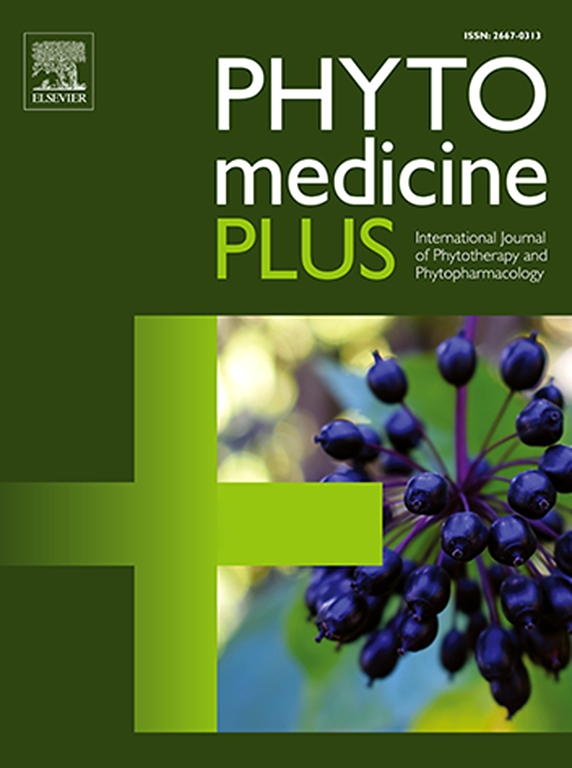Deciphering the multifaceted mechanism of Shuang Huang Lian in treating upper respiratory tract infections: A metabolomics-based network pharmacology approach
Q3 Pharmacology, Toxicology and Pharmaceutics
引用次数: 0
Abstract
Background and purpose
Shuang Huang Lian (SHL), a traditional Chinese medicine (TCM) formula consisting of extracts from Lonicerae japonicae flos, Forsythiae fructus, and Scutellariae radix, is widely recognized for its efficacy in treating upper respiratory tract infections (URTIs). Recommended by the 2011 Chinese Guidelines for Diagnosis and Treatment of Influenza, SHL's therapeutic potential has long been valued in clinical practice. However, its precise mechanisms of action against URTIs remain unclear, necessitating further exploration.
Methods
This study investigates the molecular mechanisms and identifies the key active components and pivotal protein targets of SHL in URTI treatment using a network pharmacology approach. We based our analysis on pharmacologically active SHL components we previously identified through untargeted metabolomics profiling. Key cheminformatics and bioinformatics platforms and databases, including ADMETlab, SEA, PASS, Super-Pred, SwissTargetPrediction, PharmMapper, and GeneCards, were used to predict the drug-like properties of active SHL components and identify protein targets shared between the active SHL components and the URTI-related disease genes. A protein-protein interaction (PPI) network was constructed, and gene ontology (GO), KEGG, and Reactome enrichment analyses were conducted to elucidate the biological functions relevant to URTIs. Target-target interaction (TTI) network construction and modularity analysis were also performed. Finally, pivotal protein targets and key active SHL components were validated through molecular docking simulations and in vitro cell culture experiments.
Results
Our analysis identified TNF, CASP1, and MAPK14 as pivotal protein targets in SHL's action against URTIs, with brusatol, an active SHL component, confirmed as a critical ligand that modulates these targets.
Conclusion
This comprehensive study elucidates the multifaceted mechanisms underlying SHL's efficacy in treating URTIs, supporting its traditional use and highlighting its potential for novel therapeutic development.

解读双黄连治疗上呼吸道感染的多重机制:基于代谢组学的网络药理学方法
背景与目的双黄连(SHL)是一种由金银花、连翘和黄芩提取物组成的中药配方,具有治疗上呼吸道感染的疗效。2011年《中国流感诊疗指南》推荐使用SHL, SHL的治疗潜力早已在临床实践中得到重视。然而,其对尿路感染的确切作用机制尚不清楚,需要进一步探索。方法采用网络药理学方法研究SHL治疗尿路感染的分子机制,鉴定SHL治疗尿路感染的关键活性成分和关键蛋白靶点。我们的分析基于我们之前通过非靶向代谢组学分析鉴定的药理活性SHL成分。关键的化学信息学和生物信息学平台和数据库,包括ADMETlab、SEA、PASS、Super-Pred、SwissTargetPrediction、PharmMapper和GeneCards,用于预测活性SHL成分的药物样特性,并确定活性SHL成分与urti相关疾病基因之间共享的蛋白靶点。构建了蛋白-蛋白相互作用(PPI)网络,并进行了基因本体(GO)、KEGG和Reactome富集分析,以阐明与URTIs相关的生物学功能。并进行了靶-靶相互作用(TTI)网络构建和模块化分析。最后,通过分子对接模拟和体外细胞培养实验验证关键蛋白靶点和关键活性SHL成分。结果我们的分析发现TNF、CASP1和MAPK14是SHL抗URTIs作用的关键蛋白靶点,而brusatol(一种SHL活性成分)被证实是调节这些靶点的关键配体。结论本综合研究阐明了SHL治疗尿路感染疗效的多方面机制,支持了SHL的传统应用,并强调了其开发新型治疗方法的潜力。
本文章由计算机程序翻译,如有差异,请以英文原文为准。
求助全文
约1分钟内获得全文
求助全文
来源期刊

Phytomedicine Plus
Medicine-Complementary and Alternative Medicine
CiteScore
3.70
自引率
0.00%
发文量
178
审稿时长
81 days
期刊介绍:
 求助内容:
求助内容: 应助结果提醒方式:
应助结果提醒方式:


